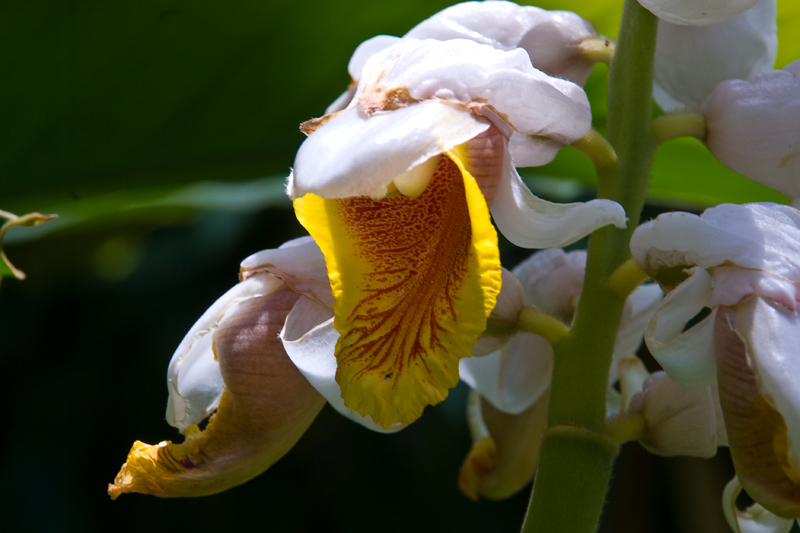Beautiful African Orchids in Pictures
Wild orchids in Southern Africa are prized for their beauty and traditional food practices.
Orchids are not only used for food but are also beautiful, fascinating, and important indicators of environmental health and biodiversity conservation. Orchids are threatened by habitat loss, overcollection, invasive species, climate change, and diseases.
Therefore, protecting and studying these remarkable plants and their interactions with their pollinators and other organisms is essential. Orchids are a treasure of nature that deserves our admiration and respect. Chikanda is a Zambian dish made from boiled orchid tubers and ground nuts and eaten as a snack or dessert. It has medicinal benefits but also faces conservation threats due to overharvesting.
Southern Africa is home to a diverse family of attractive, beautiful flowers, including the orchid, whose blooms are colorful and sweet-scented, attracting bees and butterflies. The orchid is a member of the Orchidaceae family; wild orchids are becoming increasingly challenging to find, leading to environmentalists endorsing laws to protect indigenous orchids.
Orchids are a diverse and fascinating group of flowering plants that have captivated humans for centuries. They are known for their beauty, diversity, and ecological significance. Orchids are also important sources of medicine, food, perfume, and cultural symbols for many people worldwide.
Southern African Orchids in Pictures

Southern African terrestrial orchidt grow on the ground in subtropical and tropical areas.
Orchid tubers are popular and sold in markets fresh and dried as snacks or ready-made Chikandadishesh. The Nyika Plateau of eastern Zambia and northern Malawi is world renowned for its abundant orchid plants. Orchid flowers and leaves are generally edible unless they belong to a toxic species. Orchid flowers can garnish salads, desserts, drinks, or dishes. They can also be candied, crystallized, or dried for later use. Orchid flowers have a mild flavor and a crunchy texture. Some orchid flowers have a sweet, floral, or spicy aroma that can enhance the taste of the food.
African ground orchids are threatened with extinction by illegal trade.

In the Southern African region, around 479 species in 53 genera subfamilies of wild orchids are indigenous to the region, and 65 percent are found nowhere else in the world.

Terrestrial orchids grow in the ground, epiphytic orchids grow on trees, and epilithic orchids grow on rocks. Chikanda is a traditional Zambian dish made from the boiled root tubers of terrestrial orchids, also called chikanda. It is also known as African polony, Zambian polony, or Zambian sausae, because it has a texture that resembles bologna. Chikanda can be eaten as a snack, dessert, or a side dish with nshima, a maize flour porridge.
Mohe African orchids can be found in Central and South Africa, where they grow in tropical rain forests in the Savanna. Many orchids also grow in Southern, Central, East, and West Africa, including Madagascar and Mauritius. To start growing orchids, try the Bletilla Striata orchid, also known as the Chinese ground orchid. This terrestrial orchid is easy to grow. With proper care, an orchid can be in bloom for months each year and can live indefinitely.
Bletilla striata is a terrestrial orchid that prefers organically rich, moist, well-drained soil in part shade. It can tolerate some sun but needs afternoon shade in hot climates. It can be planted 4 inches apart and 2-3 inches deep in spring. After flowering, it requires regular moisture for the rest of the growing season. It can also be grown in pots and containers and brought inside in winter in colder areas.
Bletilla striata is a beautiful example of the diversity and adaptation of wild orchids. It is not only beautiful, easy to grow, and fascinating but also important for environmental health and biodiversity conservation. However, it is threatened by habitat loss, overcollection, invasive species, climate change, and diseases.
- Where is Shashamane Ethiopia ,the African Rastafarian Promised Land
- Cooking with shea butter oil
- The worst serial killers recorded in history are women
- Indigenous healers and plants used
- Night running illness or magic
- What is back to Africa







